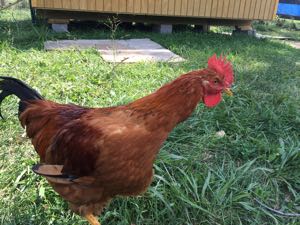 Farmers face ethical dilemmas, like what to do when you end up with more roosters than you need. When hatching eggs, you can typically expect there to be a ratio of roughly 50% males and 50% females. We need laying hens to supply our eggs, but a ratio of one rooster to up to ten hens is all that’s needed for fertile eggs and protection.
Farmers face ethical dilemmas, like what to do when you end up with more roosters than you need. When hatching eggs, you can typically expect there to be a ratio of roughly 50% males and 50% females. We need laying hens to supply our eggs, but a ratio of one rooster to up to ten hens is all that’s needed for fertile eggs and protection.
The first batch of eggs resulted in 22 viable chicks, so the odds are that as many as 11 of those could be roosters. Adding those 22 to the 7 remaining adult chickens means there would be a total of 29 chickens, with one adult rooster and possibly 11 juveniles. Clearly, that’s too many roosters, which can result in rooster injuries from dominance-related fighting and hen injuries due to overbreeding. So what do we plan to do?
We mapped out a plan before we hatched the eggs: the juveniles will be kept for as long as practical so that those with the best qualities (e.g., size, protectiveness, demeanor) will be identified and allowed to breed those traits into the flock’s bloodline. We’ll probably end up with no more than 3 roosters total. The rest will be offered for sale to other chicken owners or will be processed and put in the freezer. They’ll have good lives free ranging until the time comes to cull them, and we’ll process them as humanely as possible.
This may sound terrible to some people, but it’s a lot better than the lives of conventionally-raised chickens, especially roosters. In factory egg farms, male chicks are routinely culled upon hatching, once gender is determined, since they obviously don’t lay eggs. One common way of culling them is to throw the tiny, fluffy chicks into grinders while they’re still alive, which is referred to as “maceration”. This practice is apparently condoned by the American Veterinary Medical Association (AVMA) as an acceptable way to euthanize chicks: see page 63 of the AVMA’s Guidelines for the Euthanasia of Animals: 2020 Edition.
We think roosters have value and should be treated with the dignity and respect they deserve. If you agree, speak up with your checkbook and buy locally-raised chicken from small farms. Give the chicks a chance at a good life!

Comments are closed.